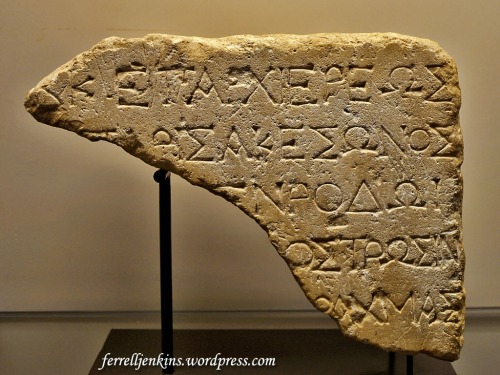Last April I had the opportunity to visit the Hecht Museum at the University of Haifa. The archaeological artifact I wish to share today is an inscription from Jerusalem describing a donation by a “Paris son of Akeson of Rhodes” for Herod’s Temple.
The sign with the artifact provides this English translation of the fragment:
year 20 (Herod reign) during the time of the High
Priest (Simon son of Boethus)
Paris son of Akeson
of Rhodes
pavement (of the southern Temple Court?)
drachmas …
The following information is provided with the inscription:
This inscription was discovered among the debris in a palace pool of the Herodian period about 70 meters south of the plaza that runs along the southern wall of the Temple Mount. The inscription mentions the donation of Paris, son of Akeson, of Rhodes, probably toward the cost of paving the Temple’s open southern court (Azara). According to Josephus, this court was paved with a variety of stones. This pavement was constructed, as the inscription notes, during the period of the Temple’s reconstruction, in the twentieth year of Herod’s reign (21 BCE), at the time of the High Priest Simon, son of Boethus.
Herod the Great ruled as King of Judea at the time of the birth of Jesus (Matthew 2:1-19; Luke 1:5). Sources I use typically show the reign of Herod as king of Judea from 37 to 4 B.C. He served as Governor of Galilee as early as 47 B.C.
The inscription is displayed in the Hecht Museum by courtesy of the Israel Antiquities Authority.
